Your browser's Javascript functionality is turned off. Please turn it on so that you can experience the full capabilities of this site.
When you’re shopping for tires online, you might come across this acronym: UTQG. It stands for Uniform Tire Quality Grade, but what does that mean, and what do you need to know about UTQG ratings?
The UTQG rating system was created to help drivers make more informed tire-buying decisions. Tire manufacturers give their own tires a grade for:
Together, these numbers make up a tire’s UTQG rating—a three-digit number plus two letters, such as 300 AA.
You can also inspect your current tires’ UTQG rating by inspecting the sidewall near the tire size.
Manufacturers arrive at these numbers by comparing a tire’s performance results to the results of a standard control tire.
What does each of the UTQG really tell you about the quality of your tires? Here’s a breakdown.
Treadwear (the durability rating)
The treadwear grade is designed to give you a picture of the durability or life you can expect from your tire. What you need to know about the treadwear grade is this: The higher the treadwear number, the longer it’ll take the tread to wear down. Higher is better.
The control tire has a treadwear grade of 100. So, if the tire being tested gets a 200 treadwear rating, that means it’s expected to take twice as long to wear out as the control tire.
To get a treadwear grade, tires run a 640-kilometre course for 11,520 km, with tread depths being measured every 1,280 to give a projected tread life.
Traction (the safety rating)
A traction grade tells you how well your tire can stop in wet conditions. The highest traction grade is AA, followed by A, B, and C.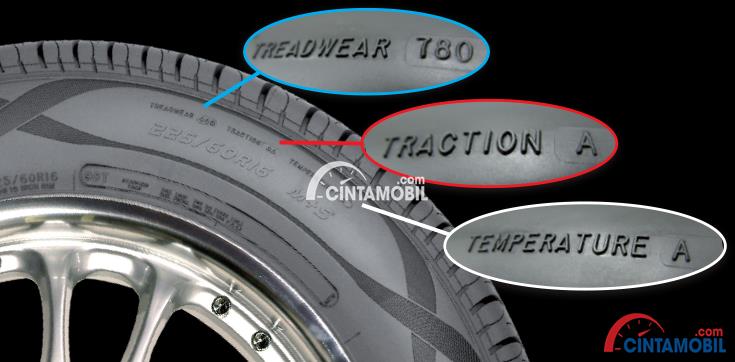 Tires with an ‘AA’ traction rating should stop at a much shorter distance than a tire with a ‘C’ rating.
Tires with an ‘AA’ traction rating should stop at a much shorter distance than a tire with a ‘C’ rating.
Temperature (the heat resistance rating)
Tires are always up against the stress of heat than can build up driving at high speeds and/or in warm weather. If a tire gets too hot, blowouts can result.
The temperature rating, tells you how well a tire is able to resist heat build-up. That heat resistance is graded with an A, B, or C, with ‘A’ being the highest and ‘C’ being the lowest.
While understanding UTQG can help you make more informed decisions when you’re comparing summer, all-season, winter or all-weather tires, remember that the grades are given by manufacturers, so they can be subjective.
For unbiased tire testing results conducted by third-party professionals in everyday Canadian driving conditions, view the Kal’s Tire Testing results for the tires you’re interested in.
Do you need help finding the right tire for your needs?
When you shop online at KalTire.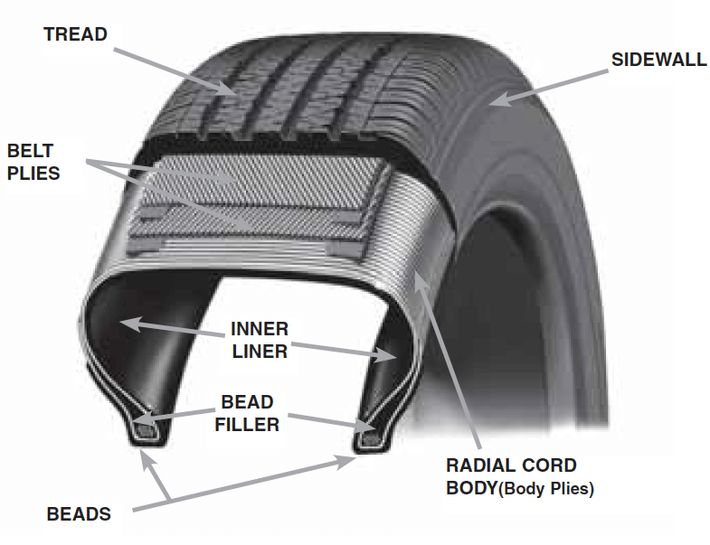 com, we ask you the same questions our team members ask in store.
com, we ask you the same questions our team members ask in store.
Shop Now
Was this article helpful?
Click on thumbs up or down to vote.
The National Highway Traffic Safety Administration, a branch of the United States Department of Transportation (US DOT), developed something called the Uniform Tire Quality Grade (UTQG) standards back in the 1970s to help tire buyers understand what they are buying.
UTQG measures three things: tread wear, traction and temperature.
The important thing to know is that the USDOT does not conduct the tests and assign ratings; manufacturers test and assign their own UTQG ratings. The NHTSA does verify the accuracy of the manufacturers’ ratings.
There is a consensus that the tire UTQG ratings don't always match up with reality because of how tests are performed. We'll discuss the meanings of each rating and how we use UTQG data to give you a base to make a tire purchasing decision.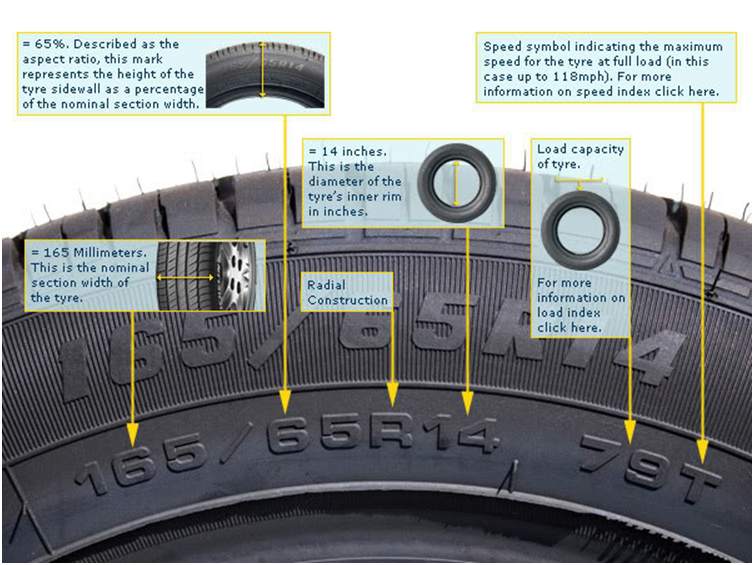.png)
UTQG tires ratings are only required in the United States for passenger tires, but they are not required for certain types of tires including snow/winter, deep-tread light truck tires, and run-flats as well as certain other tires. And, of course, your trailer tires and some other utility tires are not required to be UTQG rated.
Generally speaking, tires with a higher treadwear rating are expected to take longer to wear down under normal driving conditions. A lot of tire shoppers tend to base their purchase decisions solely on treadwear, and we are not saying you should ignore this number — but we are saying that you should consider several factors when purchasing tires in addition to treadwear.
Why? Because tire manufacturers are allowed to self-report their ratings, and also because the testing to estimate tread wear is extremely limited.
Here’s how tires are tested for tread wear: There is a testing facility in western Texas where the tire tests are conducted. Tires are mounted on a special convoy of vehicles, where the commercial tires are tested against a control group of tires. They’re driven 7,200 miles and then compared against the control group. The control tire is always assigned a grade of 100. So, if a tire is rated 400, it is expected to wear four times longer than the control tire.
Tires are mounted on a special convoy of vehicles, where the commercial tires are tested against a control group of tires. They’re driven 7,200 miles and then compared against the control group. The control tire is always assigned a grade of 100. So, if a tire is rated 400, it is expected to wear four times longer than the control tire.
The testing process gets a little murky. Manufacturers are allowed to choose their own base tires. So Company A’s control tire might differ from Company Z’s control tire, even though they’re both testing all-season SUV tires, for example. And, of course, the composition of their own brands of tires differ as well. So you could say it is not necessarily an apples-to-apples (or rubber to rubber) comparison.
We crunched the numbers from the USDOT’s database of manufacturers and found that across all brands, the average UTQG wear varies based on the intended use of the tire.
| Tread Type | Average of UTQG Wear Across All Brands |
| All Season | 504 |
| All Terrain | 506 |
| All Terrain / All Season | 546 |
| All Weather | 509 |
| Highway All Season | 428 |
| Highway Terrain | 480 |
| Highway Terrain All Season | 632 |
| Highway / Regional | 600 |
| Mud Terrain | 413 |
| On / Off Road | 474 |
| Passenger All Season | 554 |
| Performance All Season | 429 |
| Performance Summer | 264 |
| Performance Touring All Season | 509 |
| Summer | 323 |
| Touring All Season | 546 |
| Touring Summer | 392 |
| Winter | 500 |
What you need to know as a consumer: Treadwear does not tell you how many miles a tire will last.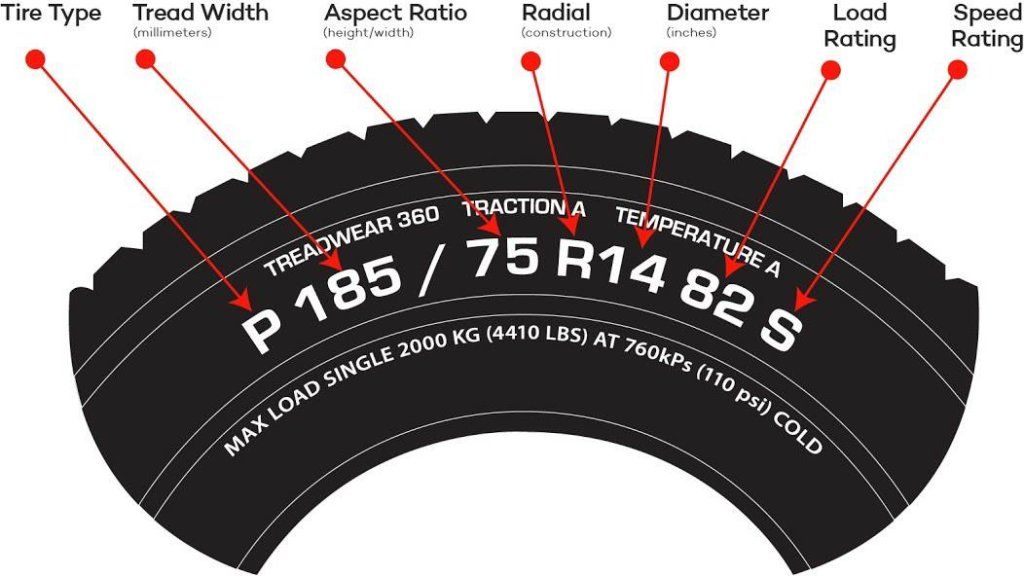 Nor does it tell you whether it is a high-quality tire. For quality information, look at the warranty and other consumers’ reviews. If a manufacturer offers an 80,000 mileage warranty, that’s a signal that they are confident in their tire’s quality.
Nor does it tell you whether it is a high-quality tire. For quality information, look at the warranty and other consumers’ reviews. If a manufacturer offers an 80,000 mileage warranty, that’s a signal that they are confident in their tire’s quality.
A few things to note about tire warranties: If you file a claim with a tire maker, you might be asked to prove you’ve taken good care of your tires, keeping them properly inflated and rotated regularly. Learn more about how tire warranties work.
According to the National Highway Transportation Safety Administration, the arm of the USDOT that governs tires, only 15% of tires are rated below 200. Generally a tire that is rated that low is intended to be used for racing or a very specific and limited application.
Tires are graded A, B, or C for heat resistance. The NHTSA says most tires are rated A; 62% of tires in the US are rated for high heat. This is important because the higher the temperature rating, the higher its ability to run safely at high speeds.
The NHTSA says most tires are rated A; 62% of tires in the US are rated for high heat. This is important because the higher the temperature rating, the higher its ability to run safely at high speeds.
Tires sold in the US must meet at least a C standard.
Traction simply refers to the tire’s ability to help a vehicle stop on wet pavement. The higher the grade, the better the tire is at stopping on wet pavement in a shorter distance. The ratings are: AA, A, B, and C. According to the NHTSA, 15% of tires are rated AA; 75% are rated A, and 7% are rated B. Only four lines of tires are rated C, and these are racing tires that are not intended for general consumer driving or everyday use!
Source: GoodyearIs a higher UTQG rating better? In a world where “the higher the rating the better” tends to be the rule, we’re going to say, “Yes … but with a big HOWEVER …”
The UTQG rating measures treadwear, temperature and traction.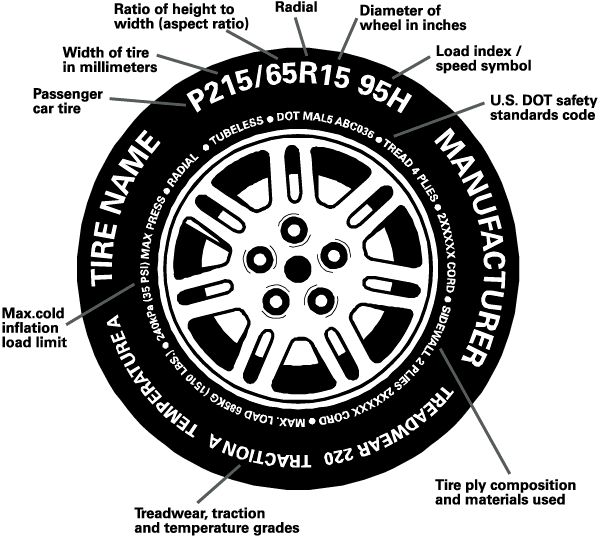 HOWEVER, a low tire rating doesn’t necessarily mean it’s a bad tire. It simply means that when it was compared to a control tire, it met or didn’t meet the control tire’s treadwear, traction, and temperature.
HOWEVER, a low tire rating doesn’t necessarily mean it’s a bad tire. It simply means that when it was compared to a control tire, it met or didn’t meet the control tire’s treadwear, traction, and temperature.
If you don’t put a lot of hard miles on your vehicle — say you’re retired, it’s a second car, or you work from home — then a mid-priced tire with a lower UTQG treadwear rating might be right for you.
If you spend a good part of your day commuting to and from work, you travel a lot, or you are just a fan of weekend road trips, then you’re going to look for a tire that tends to handle well and reduces road noise, in addition to having higher expected treadwear.
If you drive a sports car or a high-performance vehicle, then you’ll want to find tires that match your driving style, even if it is a little on the aggressive side. Maybe you live near the Pacific Coast Highway or Appalachian Mountains with lots of winding roads and turns, and you need something that handles well.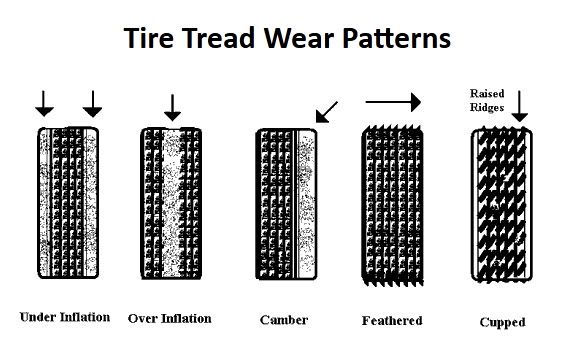 Here you might sacrifice treadwear in favor of grip and handling.
Here you might sacrifice treadwear in favor of grip and handling.
Start by searching for your make, model, year and trim level at the top of any Tire Agent page. Then make sure the size recommendations match your vehicle’s size. Tire Agents tire-matching software will suggest a number of options for your vehicle, and you can select and compare based on your budget, driving style, and personal preference.
We know that buying tires can be confusing with so many options. Our agents are standing by to help you choose the right tire for your vehicle. Click to call (833) 847-3463, use the live chat feature in the bottom left of your screen, or write to us at [email protected]
Next Post:
Guide to Traction Rating on Passenger Tires
Do you want to choose a tire for your car, but do not understand tire markings well? It's not a problem! In this section, we will help you figure out what tire parameters are, what they mean, and which tire is right for your car.
195/65 R15 91 TXL
195 is the tire width in mm.
65 - Proportionality, i.e. profile height to width ratio. In our case, it is equal to 65%. Simply put, with the same width, the larger this indicator, the higher the tire will be and vice versa. Usually this value is simply called “profile”.
Since the tire profile is a relative value, it is important to take into account when choosing rubber that if you want to put tires with a size of 205/65 R15 instead of the size 195/65 R15, then not only the width of the tire will increase, but also the height! Which in most cases is unacceptable! (except when both of these sizes are indicated in the car's operating book). You can calculate the exact data on changing the outer dimensions of the wheel in a special tire calculator.
If this ratio is not specified (for example, 185/R14C), then it is equal to 80-82% and the tire is called full profile. Reinforced tires with this marking are usually used on minibuses and light trucks, where a large maximum wheel load is very important.
Reinforced tires with this marking are usually used on minibuses and light trucks, where a large maximum wheel load is very important.
R - means a tire with a radial cord (in fact, almost all tires are made this way now).
Many mistakenly believe that R- means the radius of the tire, but this is precisely the radial design of the tire. There is also a diagonal design (indicated by the letter D), but recently it has practically not been produced, since its performance is noticeably worse.
15 - wheel (rim) diameter in inches. (It is the diameter, not the radius! This is also a common mistake). This is the “landing” diameter of the tire on the disk, i.e. is the inside size of the tire or the outside of the rim.
91 - load index. This is the level of maximum permissible load on one wheel. For passenger cars, it is usually done with a margin and is not a decisive factor when choosing tires (in our case, IN - 91 - 670 kg.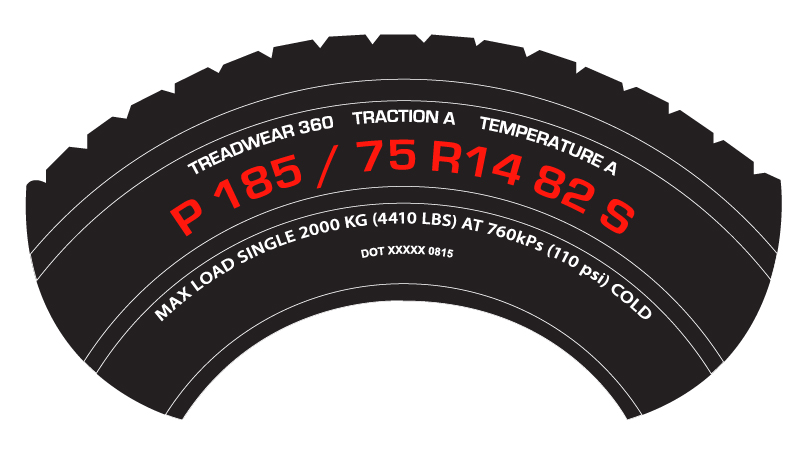 ). For minibuses and small trucks, this parameter is very important and must be observed.
). For minibuses and small trucks, this parameter is very important and must be observed.
T - tire speed index. The larger it is, the faster you can ride on this tire (in our case, IS - H - up to 210 km / h). Speaking about the tire speed index, I would like to note that with this parameter, the tire manufacturer guarantees the normal operation of the rubber when the car is constantly moving at the specified speed for several hours.
There are two different markings for American tires. The first one is very similar to the European one, only the letters “P” (Passanger - for a passenger car) or “LT” (Light Truck - light truck) are placed before the size. For example: P 195/60 R 14 or LT 235/75 R15. And another tire marking, which is fundamentally different from the European one.
Example: 31x10. 5 R15 (corresponding to European size 265/75 R15)
5 R15 (corresponding to European size 265/75 R15)
31 is the outside diameter of the tire in inches.
10.5 is tire width in inches.
R - a tire with a radial design (older tire models were with a diagonal design).
15 is the inner diameter of the tire in inches.
Generally speaking, except for inches that are unusual for us, the American tire marking is logical and more understandable, unlike the European one, where the height of the tire profile is not constant and depends on the width of the tire. And here everything is simple with decoding: the first digit of the standard size is the outer diameter, the second is the width, the third is the inner diameter.
XL or Extra Load is a reinforced tire, the load index of which is 3 units higher than that of conventional tires of the same size.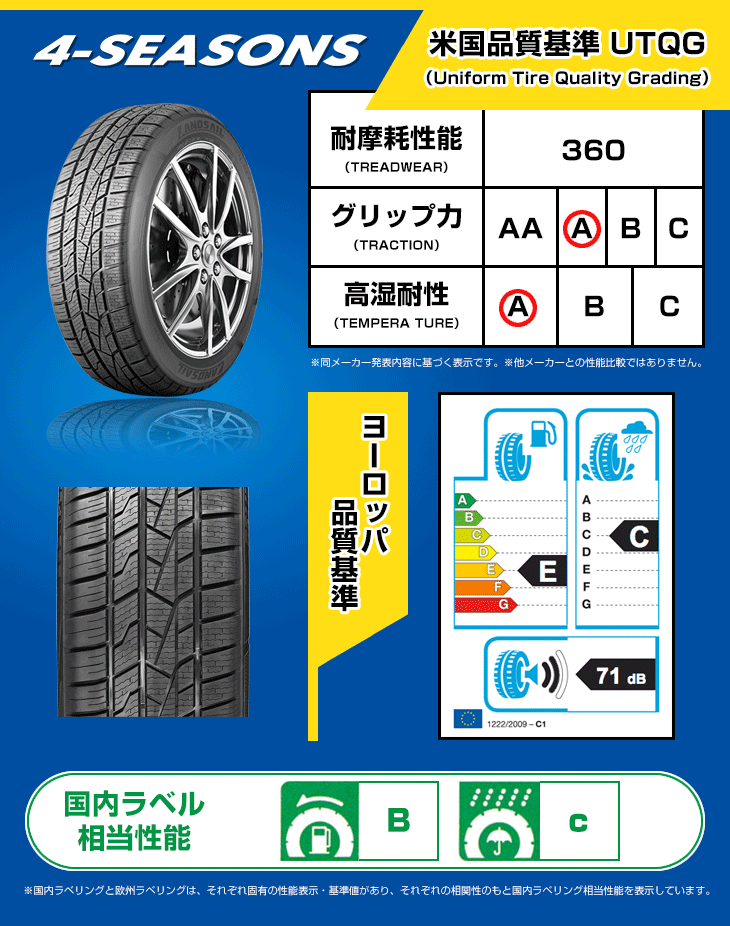 In other words, if a given tire has a load index of 91 marked XL or Extra Load, then this means that with this index, the tire is able to withstand a maximum load of 670 kg instead of 615 kg (see the table of tire load indices).
In other words, if a given tire has a load index of 91 marked XL or Extra Load, then this means that with this index, the tire is able to withstand a maximum load of 670 kg instead of 615 kg (see the table of tire load indices).
M+S or M&S tire marking (Mud + Snow) - mud plus snow and means that the tires are all-season or winter. Many summer tires for SUVs are labeled M&S. However, these tires must not be used in winter, as winter tires have a completely different rubber compound and tread pattern, and the M&S badge indicates good flotation performance.
All Season or AS all season tires. Aw (Any Weather) - Any weather.
Pictogram * (snowflake) — rubber is designed for use in harsh winter conditions. If this marking is not on the sidewall of the tire, then this tire is intended for use only in summer conditions.
Aquatred, Aquacontact, Rain, Water, Aqua or pictogram (umbrella) - special rain tires.
Outside and Inside ; asymmetric tires, i.e. It is important not to confuse which side is the outside and which is the inside. When installing, the Outside inscription must be on the outside of the car, and Inside on the inside.
RSC (RunFlat System Component) - RunFlat tires are tires on which you can continue to drive a car at a speed of no more than 80 km / h with a FULL drop in pressure in the tire (due to a puncture or cut). On these tires, depending on the manufacturer's recommendations, you can drive from 50 to 150 km. Different tire manufacturers use different designations for RSC technology. For example: Bridgestone RFT, Continental SSR, Goodyear RunOnFlat, Nokian Run Flat, Michelin ZP etc.
Rotation or arrow This marking on the tire sidewall indicates a directional tire. When installing the tire, you must strictly observe the direction of rotation of the wheel, indicated by the arrow.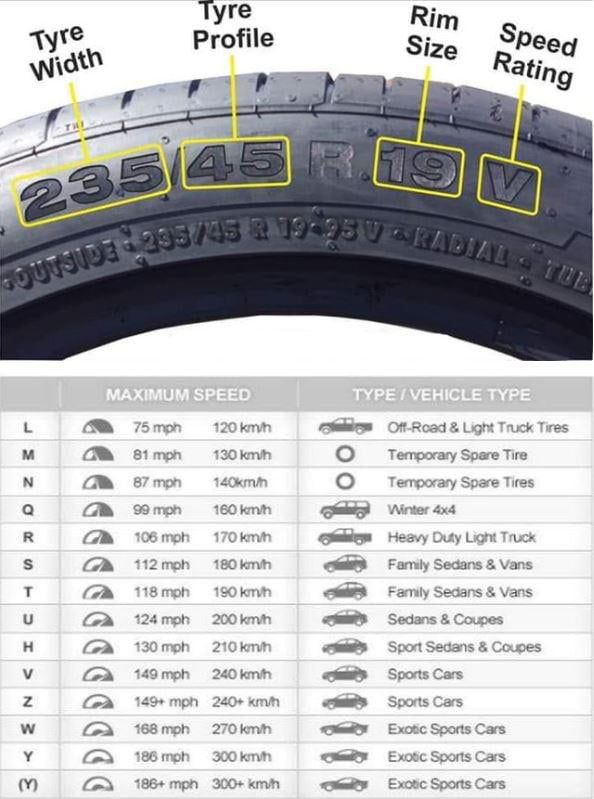
Tubeless - tubeless tire. In the absence of this inscription, the tire can only be used with a camera. Tube Type - indicates that this tire must be used only with a tube.
Max Pressure ; maximum allowable tire pressure. Max Load - the maximum allowable load on each wheel of the car, in kg.
Reinforced or the letters RF in the size (for example 195/70 R15RF) means that this is a reinforced tire (6 layers). The letter C at the end of the size (for example 195/70 R15C) indicates a truck tire (8 layers).
Radial this marking on the rubber in the standard size means that this is a radial construction tire. Steel means that there is a metal cord in the tire structure.
Letter E (in a circle) - the tire meets the European requirements of ECE (Economic Commission for Europe). DOT (Department of Transportation - US Department of Transportation) is an American quality standard.
Temperature A, B, or C Temperature resistance of the tire at high speeds on the test bench (A is best).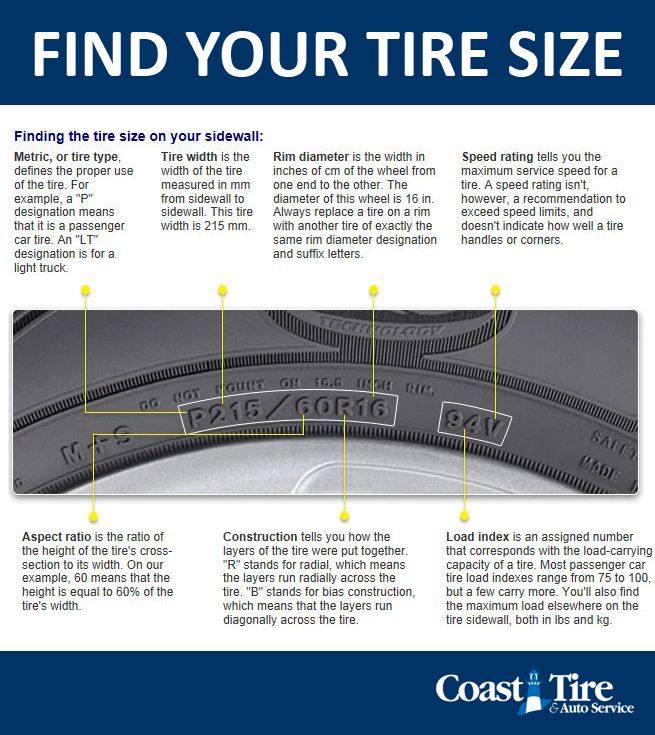
Traction A, B, or C Tire wet braking capability.
Treadwear ; relative expected mileage compared to a specific US standard test.
TWI (Tread Wear Indiration) - tire tread wear indicators. The marking on the TWI wheel can also be with an arrow. Pointers are located evenly in eight or six places around the entire circumference of the tire and show the minimum allowable tread depth. The wear indicator is made in the form of a protrusion with a height of 1.6 mm (the minimum tread value for light vehicles) and is located in the tread recess (usually in the drainage grooves).
DOT - Manufacturer's coded address, tire size code, certificate, issue date (week/year).
Find tires / tire catalogPhoto: Shutterstock
adv.rbc.ru
See also
Numbers and letters on a car tire provide all the necessary information about it.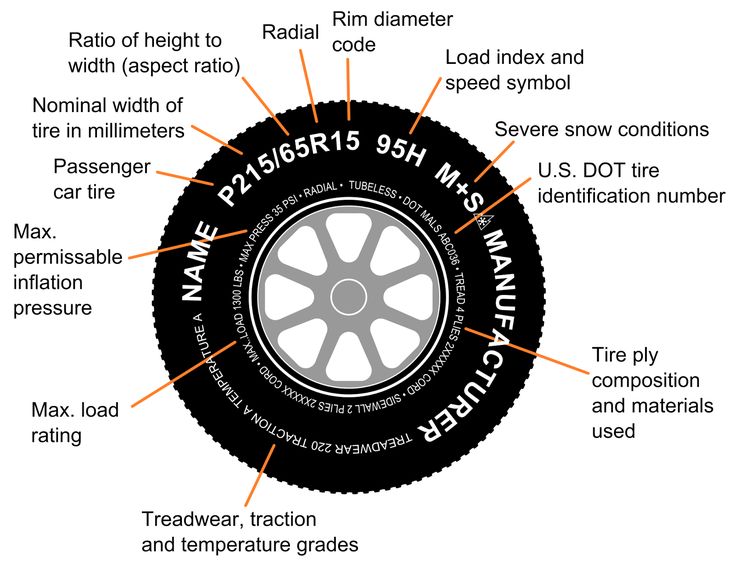 True, it is not easy to read them - here, even in the designation of one parameter, several measurement systems can be used simultaneously. In addition, many values are expressed in special indices. We decipher all important labels for the buyer.
True, it is not easy to read them - here, even in the designation of one parameter, several measurement systems can be used simultaneously. In addition, many values are expressed in special indices. We decipher all important labels for the buyer.
adv.rbc.ru
A tire label is information about its properties printed on the outer rim. This is a huge amount of useful information. Here are the parameters of the tire that can be read from it itself:
The size designation is written in the form XXX/XX R XX.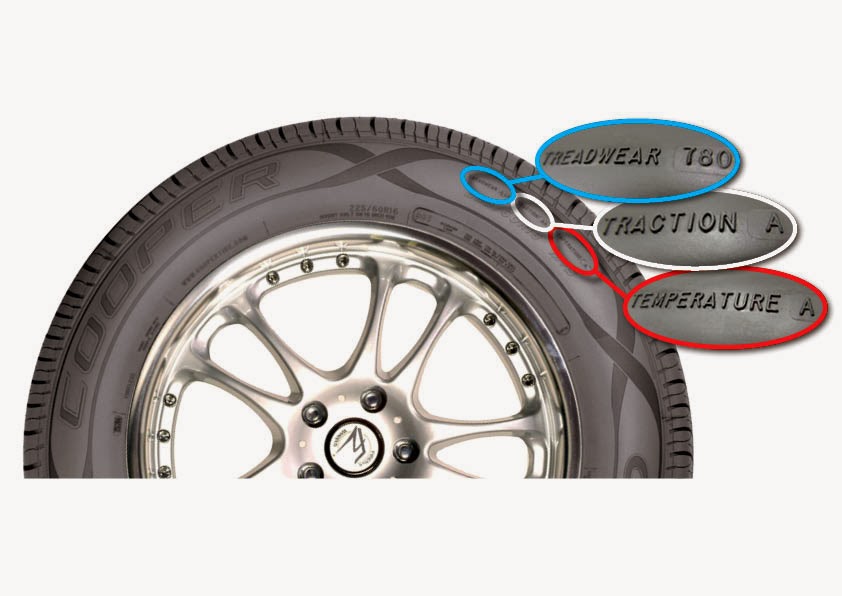 For example 225/65 R17.
For example 225/65 R17.
The first three digits are the tire width in millimetres. In our case - 225 mm.
The second digit is the height, but not in millimeters, but as a percentage of the width. In our case, its height is 146.25 mm (225 * 0.65).
The third number after R is the outside diameter of the wheel or the inside diameter of the tire in inches. In our case, this is 17 inches or 43.18 cm. Do not confuse - this is the radius, not the diameter. The letter R itself stands for the radial design of the tire, which confuses many. Sometimes Radial can be written separately on the bus - the meaning is the same. In addition to the radial, there is also a diagonal design (D), but these are not found today.
Two numbers and a letter immediately follow the size. These are the codes for the load capacity and speed limit of the tire.
Two digits - capacity or load index. This is a complex system of values, in which the larger the number, the greater the load, but the step size between the values is not constant.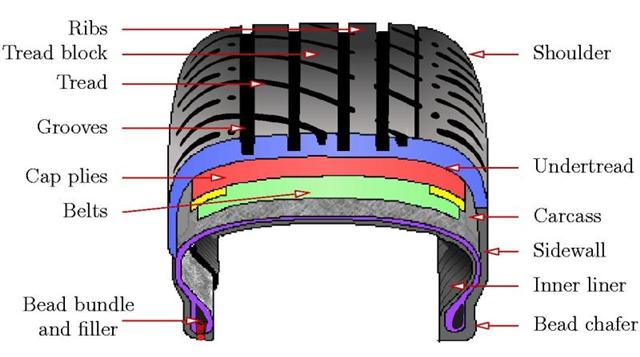 Therefore, it is easier to just know the most common of them:
Therefore, it is easier to just know the most common of them:
The index value is the load on each wheel separately. To calculate the total load capacity, multiply by 4.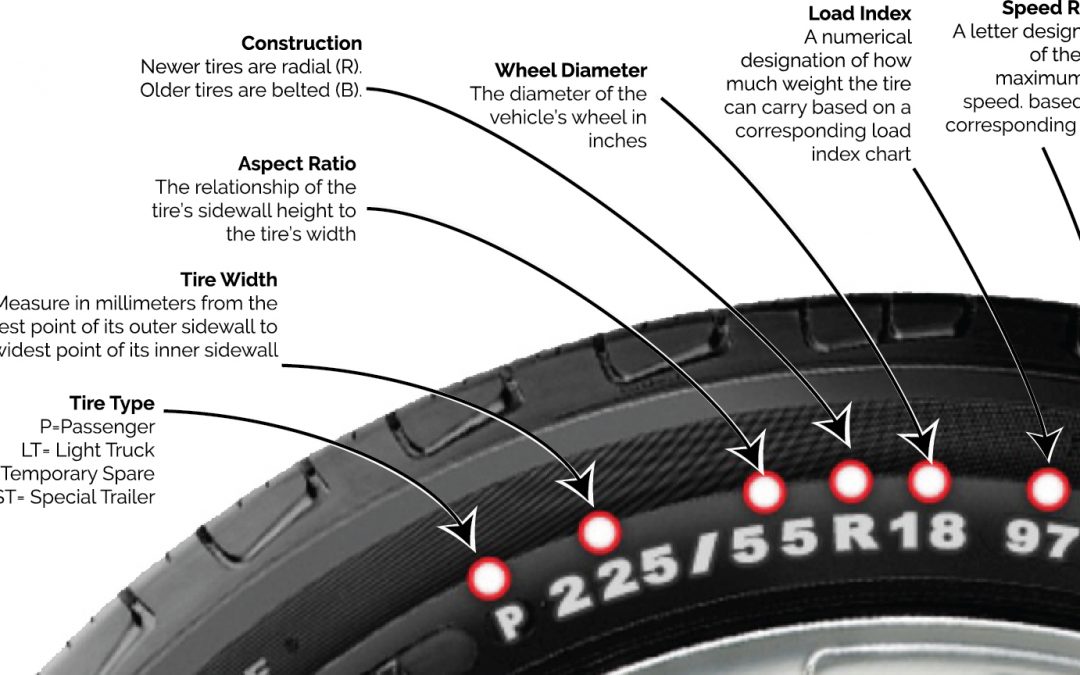 This value can also be written elsewhere in a simpler form: Max load - xxx kg.
This value can also be written elsewhere in a simpler form: Max load - xxx kg.
Photo: Shutterstock
The letter after the two digits of the load index is the index of the maximum speed for which the tire is designed. It starts with A, but the values relevant for modern machines start with the second half of the Latin alphabet:
This is not the limit, but the maximum "comfortable" value. In exceptional cases, you can even exceed it by 20-30%, but it is better to avoid this.
Another key parameter is the time the tire was produced.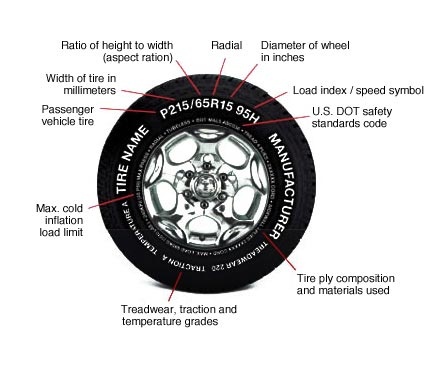 Usually it is indicated in a rounded rectangle, but may be without a frame. The first two digits are the week, and the second two are the year.
Usually it is indicated in a rounded rectangle, but may be without a frame. The first two digits are the week, and the second two are the year.
Also, three more parameters are usually indicated on the tire - wear resistance margin, grip quality class and temperature index.
The wear index is denoted by the word treadwear. Its unit is 480 km. Multiply the number next to that word by that value. If treadwear is 400, it means that under test conditions at the test site, such a tire has worn out after driving 192,000 km. Also, this parameter can be designated separately as the abbreviation TWI.
Traction is a measure of how well a tire grips on wet road surfaces. It has values from AA - the best level, to CC - the worst. Tires for regular passenger cars usually have class A, and the highest class is for sports and racing.
Temperature is the tire's ability to withstand heat when driving at a certain speed. There are three values here:
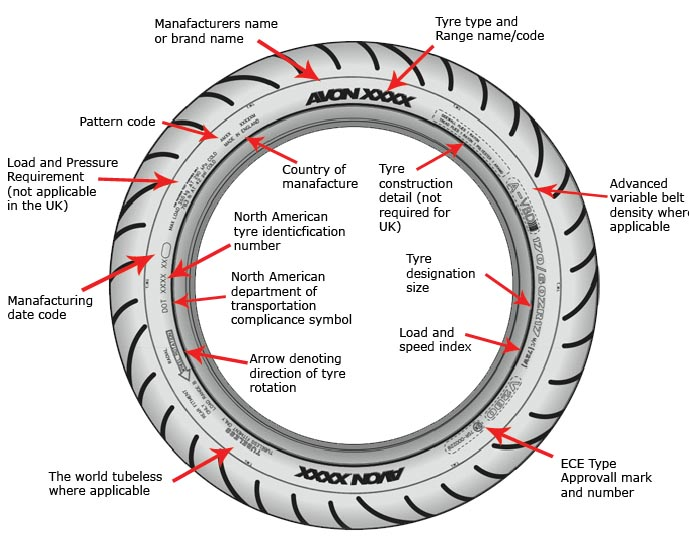
Tires of modern passenger cars most often have this index value - A.
Photo: Shutterstock
The letter E with a number indicates that the tire complies with the rules of the European Tire Standards Association (ETRTO) and has a corresponding certificate . The number indicates the country that issued it - but this does not matter, since the ETRTO requirements are the same. In this case, the tire can be produced anywhere.
The weather conditions in which this tire is allowed to be used are also usually indicated:
Winter tires must have a first, second or third designation.
On some tires you can find the designation of the type of car for which they are intended:
In addition, the tire may be marked:
